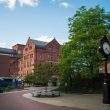Treez in the ‘hood: a look at city parks
In the last several decades, the list of problems that big cities must deal with has grown longer and longer. From affordable housing to combined sewer overflows to rampant crime and poverty, the problems are growing worse and their solutions more expensive. Given these ills, providing green spaces for urban residents has often paled in importance.
But with citizen voices growing louder and studies pointing to the significance of recreation to society and efficacy of parks in revitalizing downtown economies and property values, many cities are beginning to re-evaluate old assumptions. In Portland, Ore.; Boston; Seattle and New York, for example, officials are adopting long-term planning and land-purchase policies, as well as some innovative land-use policies, to ensure the availability of park land for years to come.
“If we want to have a plan of trails and parks, we have to do something now. We cannot sit back and watch development happen,” says Ron Klein, senior regional planner and outreach education specialist for the Metropolitan Greenspaces program in Portland, Ore.
REGIONAL PLANNING
In addition to creating recreational space, downtown parks provide buffers between business and residential areas and allow cities to capitalize on what makes them unique. New Orleans, for example, is looking at creating an historical downtown park that will celebrate the evolution of jazz.
An often-overlooked benefit of parks is their effect on crime, which was recently documented by the San Francisco-based Trust For Public Land (TPL). In a report entitled Green Cities Initiative, TPL concludes that crime rates drop when adequate parks and recreational activities are available in innercity neighborhoods. Yet two-thirds of the 23 cities surveyed have their highest concentration of park land in more affluent neighborhoods, leaving low-income, inner-city areas with insufficient facilities.
“You talk about parks, and people think ‘that’s nice’ but do not necessarily think it is important,” says Susan Ives, TPL vice president and director of public affairs. “But when you talk about crime, you get people’s attention. People are [making] correlations between parks and safe areas.”
In Portland, where planners expect the metro population to grow by more than one million by 2040, safety is just one of the reasons the city is expanding its park land. “People have realized there are many components to a livable environment,” Klein says. “Being able to play and get away is as important as finding a nice house in a safe neighborhood. Parks and green spaces are components of good human habitat.”
Portland’s `Greenspaces.’ Since 1992, Portland’s Metro Council, an elected body that oversees land-use planning, solid waste management, entertainment and green spaces in three counties and 24 cities in the metro area, has labored over the city’s Greenspaces program. With money from a $135.6-million bond measure, slated to go before voters this March, the council plans to purchase about 6,000 acres of land in 14 target areas throughout the region and to finance five regional trails and more than 80 local green space projects.
The Metro Council has worked with a consortium of government agencies, conservation groups, businesses, neighborhood associations and citizens. This type of “regional” management — planning with the involvement of a broad geographic and demographic base – can be an efficient tool for cities because it promotes logical coordination and cost-effective use of an area’s resources.
“Planning on a regional basis is critical to recognize the significance of large-scale, open-space systems such as greenways, greenbelts, watersheds, trail systems, flood-prone areas and wildlife corridors,” according to TPL. “A regional approach to financing open space acquisition usually benefits core cities, which can share the fiscal strength of their financial partners.”
Boston’s Bay Circuit Trail. As in Portland, regionalization has proven successful in Boston, where the Bay Circuit Alliance, a private coalition of 25 local, six regional and four state organizations, is coordinating the construction of the Boston Bay Circuit Trail. When completed, the 200-mile trail will connect parks, green spaces and historical areas of 50 towns in the metro-Boston area.
Conceived in the 1920s as a plan to create an automobile touring route, the Bay Circuit concept matured into a land preservation plan under the state’s Department of Environmental Management. In 1989, due to lack of funding, Massachusetts turned the project over to the Alliance. The Alliance, in turn, made each participating town responsible for the completion of its own section of the trail.
“There is a tremendous power in communities working together,” says Allen French, Alliance chairman. “We have made more progress than one state agency could.”
One hundred miles of the trail have been completed, and organizers predict the project will be finished by 2000. Placing it outside the realm of bureaucratic budget wars has contributed to its progress, says Susan Zieglar, former state director of the Bay Circuit Trail.
Decentralization has also had a positive effect on cost, says French. “The volunteers are the capital.”
Powerful Public
Financing has long been an obstacle to parks development, and even the nation’s largest source of funding — the federal Land and Conservation Fund — has been appropriating less than one-third the amount it is empowered to give. From 1985 to 1990, for example, no money was allocated; in 1991, only 412 of 2,660 requested state grants were awarded; and in 1994, only $5 million of a planned $100 million was allocated.
“We have not had the political leadership at the federal level to make funding a priority,” says TPL President Marty Rosen. “There are not enough people putting pressure on Washington to make it a priority.”
‘Common’ Effort In Seattle. In the absence of federal and state assistance, more and more cities and counties are discovering the power of the private sector in providing badly needed resources for parks development. No city illustrates this better than Seattle, where, in response to his article calling for the construction of a large downtown park, Seattle Times columnist John Hinterberger began receiving unsolicited money from readers who agreed with him.
In 1991, the money from the readers was used to help found the nonprofit Committee for the Seattle Commons, which, with the help of private contributions and more than 1,000 volunteers, has developed a revitalization plan that encompasses 470 acres.
If approved in a February referendum, the Seattle Commons project will consist of a 74-acre park, a restored lake and shore, streets designed to accommodate cyclists and pedestrians and diverse urban villages where people can live, work and play without having to use automobiles. The committee’s plans also include more than 2,700 affordable housing units, and this phase of the project is already underway.
Residents believe the Commons will revitalize the downtown area both economically and aesthetically and that incorporating the park with mixed zoning will foster diversity. “After 6 p.m., downtown is dead, making it unsafe,” says Gary Davis, community relations director for the Seattle Commons committee. “We think the Commons will change that and attract people to live downtown. It will definitely be a magnet for all kinds of activities.”
The committee has been able to attract a broad band of investors, including Boeing; Seafirst Bank; Craig and Wendy McCaw of McCaw Cellular Communications, who together have contributed more than $2 million; and Paul Allen, co-founder of Microsoft, who has made more than $20 million available in loans. About 2,000 smaller investors have contributed $2 million.
As with the Bay Circuit Trail, the momentum behind the Commons project is attributed to volunteers, many of whom have contributed park design, public safety, housing and public relations in addition to financing. “We started out with a few people and realized that the best way to forward the project was to recruit people with different interests and skills,” Davis says.
Last July, a local design firm got involved with the project by sponsoring a competition for the design of one section of the park. The Callison Partnership’s competition drew entries from more than 20 architectural schools in 11 nations and was won by Rachel Stevenson and Peter Culley, fourth-year exchange students from England attending the University of Washington.
Instilling a proprietary feeling among residents is key to the project’s success, Davis explains. “When people begin to work on a project together, they have part ownership.” A feeling of pride is “critical,” he adds.
Making Room
In addition to scarcity of money, one of the greatest obstacles to urban park planning is scarcity of land. To promote cost and space efficiency, TPL recommends that cities investigate the possibility of purchasing or converting low-cost sites such as:
* federal land holdings, including decommissioned military bases, airports and foreclosed property;
* abandoned railroad properties, which are often located in prime areas such as waterfronts and downtowns;
* surplus highway lands that are left after highway projects are scaled down or relocated;
* former landfills, junkyards and other degraded sites;* vacant inner-city lots; and* privately owned open lands in fast-growing areas.
For innovative land use, however, cities will find it difficult to beat New York’s Riverbank State Park in Harlem. The 28-acre park — featuring a 40,000 square foot gymnasium, indoor and outdoor swimming pools,, an 84,000 square foot skating rink, an amphitheater, locker rooms, weight rooms, handball and tennis courts, a track, a softball field and community gardens — sits atop the North River Water Pollution Control Facility, a sewage treatment plant on the banks of the Hudson River.
This unique facility — the only one of its kind in the country — took two years to construct and involved the cooperative efforts of city and state government agencies. Initially, the idea of a sewage treatment plant was not palatable to area residents, says Riverbank Director Gaspar Santiago. But the idea of a 10-block park in New York City was.
“The community needed recreational resources and respite from o city life,” Santiago says. “The park has provided opportunities for youngsters who would have never had an opportunity to participate in [organized] activities.”
Economic Wellbeing
In addition to documenting the recreational benefits of urban parks and greenways, TPL’s Green Cities Initiative ranks their potential economic impact. Green spaces “help cities revitalize their economies, says TPL’s Ives. “Businesses look to locate in areas with a high quality of life. And land adjacent to parks and green spaces has a higher property value, which means more tax revenue.”
The Committee for Seattle Commons and the city of Seattle each commissioned 30-year economic impact studies for the Commons project. They concluded that:
* tax revenues generated from the project will be between $1.2 and $1.3 billion;
* expenses incurred by the city for basic services — e.g., general government, police and courts, fire, library, human services and park maintenance and operations — will be between $74 and $77 million, while the net present value of income from the planning area will exceed $155 million;
* private investments for building improvements will range from $2.3 to $2.4 billion; and
* the city can expect a net increase of 16,500 to 22,600 permanent jobs, not including temporary construction, manufacturing or vendor jobs.
For many years, city officials and residents alike were all too willing to sacrifice parks and green spaces for the availability of services more “necessary” than recreation. Today, that is changing with the recognition of parks as more than just open ball fields and picnic spots.
By strategically planning open spaces, cities not only provide their citizens with an urban getaway, but also ensure the economic and environmental health of their neighborhoods and preserve their vitality and safety.
Early last summer, Schenectady, N.Y.’s Carrie Street Park, a 2-acre neighborhood park in the city’s North End District, was in a state of decline. Budget cuts afforded only minimal grounds maintenance, and recreational equipment — most of it installed when the park was built 25 years ago — was severely outdated or missing.
“It’s unfortunate, but shrinking city budgets typically impact small neighborhood parks the most,” says Schenectady Parks and Recreation Department Director William Seber. “Carrie Street Park was no exception, which was a shame because a lot of children live in the area.”
Determined to restore the park, the North End Homeowners Association (NEHA) joined forces with the Committee for the Preservation of Schenectady City Parks and approached a corporate partner to share equipment and maintenance costs.
Houston-based PSG operates Schenectady’s wastewater treatment and biosolids composting plants. “With Carrie Street Park less than a mile from the wastewater complex, the company seemed a likely candidate for helping us revitalize the park,” says NEHA Member Dion Bagnato.
With funds provided through the partnership, equipment such as swing sets, see-saws and basketball goals were purchased immediately. Old but usable equipment was renovated and repainted.
Working with neighborhood volunteers and Parks and Recreation personnel, partnership members were able to install new equipment, repair the basketball court surface and refurbish the park’s baseball diamond. Volunteers also fertilized and trimmed the grounds.
By late summer, the Carrie Street Park revitalization project was complete, and the park was filled with children. “Because the park had not been used for so many years, the completion of the project was truly an exciting event for a lot of the area kids,” Bagnato says. “Many of them hadn’t even known that there was a park here.”
Local PSG staffers are responsible for ongoing grounds maintenance, including grass seeding, mowing, edging and trimming.




















